Making outdoor wreaths is much more simple than the indoor wreaths in the previous "Indoor Wreath" blog post.
 For this project you are going to need grapevine dried into a circle, covered wire, thin light wire, pinecones and evergreen branches. You can also add any little red berries and bells that you might have and you will need a big bow.
For this project you are going to need grapevine dried into a circle, covered wire, thin light wire, pinecones and evergreen branches. You can also add any little red berries and bells that you might have and you will need a big bow.
 Start with the same grapevine as in the previous post. The directions are the same as far as making the initial wreath, however, for an outdoor wreath you need to wrap the wire closer. All of the greenery stem will be held in place by the wire, so it needs to be wrapped close for a full wreath.
Start with the same grapevine as in the previous post. The directions are the same as far as making the initial wreath, however, for an outdoor wreath you need to wrap the wire closer. All of the greenery stem will be held in place by the wire, so it needs to be wrapped close for a full wreath.
 When you have the wreath completely wrapped with wire and the hanger on the back then you prepare the pinecones. Any pinecones will look good. I have both the short, squat, round ones and the long, curved ones. I am going to use the long, curved ones for this wreath. The pinecones are wired to the wreath so they can withstand outdoor winds.
When you have the wreath completely wrapped with wire and the hanger on the back then you prepare the pinecones. Any pinecones will look good. I have both the short, squat, round ones and the long, curved ones. I am going to use the long, curved ones for this wreath. The pinecones are wired to the wreath so they can withstand outdoor winds.
After you have wired all of the pinecones you plan to use, you can start to attach them to the wreath. Wrap the wire around the wire on the wreath, securing the base of the pinecone. Take a small piece of wire and also secure the top of the pinecone to the wreath, making sure the wire does not show. This will keep the pinecones from coming off in a storm or hanging down if they become loose.


When all of the pinecones are attached, you begin to add the greenery.
 Cut the greenery into small pieces. I have collected both pine and cedar here. It takes a lot to make a wreath, more than you think. I made one large full wreath from one wheel barrow full of greenery. Any everygreen will make a nice wreath. I have also used spruce which looks very nice. I particularly like the cedar due to the sweet scent, but the spruce has a stong everygreen scent that is nice too.
Cut the greenery into small pieces. I have collected both pine and cedar here. It takes a lot to make a wreath, more than you think. I made one large full wreath from one wheel barrow full of greenery. Any everygreen will make a nice wreath. I have also used spruce which looks very nice. I particularly like the cedar due to the sweet scent, but the spruce has a stong everygreen scent that is nice too.

This is about the right size for a wreath. I cut a small pile to start with and continue to cut them as I go.
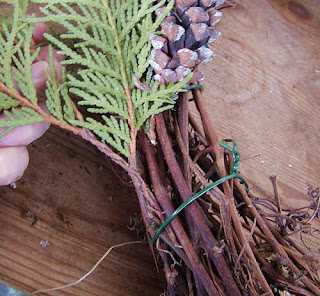
Stick the bottom of the cut branch piece under the wire. I do across the wreath in one area first, getting the outside of the circle and the inside, as well as the front. It is not necessary to leave spaces for the pinecones as you can cut the tiny pieces hiding the pinecones off the branch later.
Go all the way around the wreath, making it as full as you can. When you have done the entire circle, go back and fill in any open spots until you are happy with the wreath.

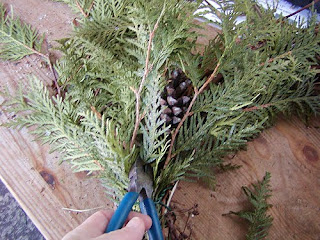 Using the clippers, remove any small pieces that cover a pinecone. Make sure you leave enough greenery to cover any wire.
Using the clippers, remove any small pieces that cover a pinecone. Make sure you leave enough greenery to cover any wire.

When your wreath is completely filled in and finished, it is time to add the bow.
 Directions for making a bow are on the previous "Indoor Wreath" blog post.
Directions for making a bow are on the previous "Indoor Wreath" blog post.

Wire the bow onto the wreath. You can wire two long pinecones handing down under the bow and some berries above it. You will need to attach wire to any berries, bells or other decorations you want to add. Everything needs to be wired on to withstand the freezing temps and winds outdoors.

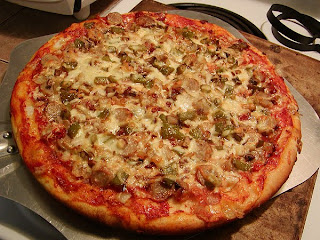
We LOVE pizza, especially homemade pizza. I have a good recipe for the dough that makes in my breadmaker. Well, it makes up to the "roll it out" stage. This dough recipe uses a cup of beer for the liquid which gives the dough an especially "yeasty" flavour that is really delicioius! It can be flat so you can save a cup of beer in the fridge for awhile, planning to make your own pizza dough.
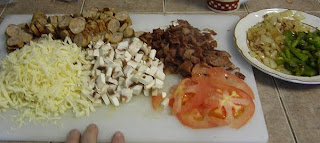 You can put as much cheese as you want on your own pizza. You can put whatever toppings you like and as much of them as you want, on your own pizza. It is more trouble than buying delivered pizza but it is a LOT cheaper. It is more trouble than buying a frozen pizza from the grocery store, but it is a LOT better.
You can put as much cheese as you want on your own pizza. You can put whatever toppings you like and as much of them as you want, on your own pizza. It is more trouble than buying delivered pizza but it is a LOT cheaper. It is more trouble than buying a frozen pizza from the grocery store, but it is a LOT better.
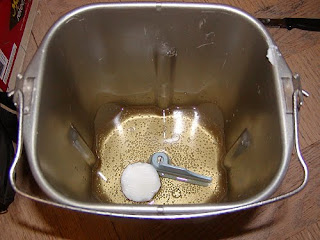 You don't have to use a breadmaker for this, its just easier. I let the dough mix and knead in the breadmaker. If you are using a breadmaker for this and are putting the ingredients in early in the morning to mix and knead later, or even the day before, it is important that the ingredients be put into your breadmaker in this order. This keeps the yeast away from the liquid, salt and sugar until it is ready to mix.
You don't have to use a breadmaker for this, its just easier. I let the dough mix and knead in the breadmaker. If you are using a breadmaker for this and are putting the ingredients in early in the morning to mix and knead later, or even the day before, it is important that the ingredients be put into your breadmaker in this order. This keeps the yeast away from the liquid, salt and sugar until it is ready to mix.
This is the pizza dough recipe we use:
1 cup beer or water (Use beer. It makes delicious crust!)
1 tablespoon shortening
1 tablespoon sugar
1 teaspoon salt
2 3/4 cups all purpose flour in Canada
or 3 cups bread flour in the US (I have no idea?? - anyone??)
1 1/4 teaspoon yeast
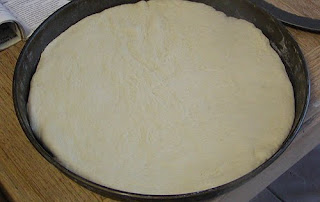 Put all ingredients into machine in the above order. Put machine on "dough/pasta" setting. When cycle is complete, remove dough and roll out to fit bottom of pan.
Put all ingredients into machine in the above order. Put machine on "dough/pasta" setting. When cycle is complete, remove dough and roll out to fit bottom of pan.
This recipe makes one extra large pizza or two small pizzas. I always make one extra large one.
I have a pizza stone, but I bake this in a pizza pan with bacon grease in the bottom. You can put melted butter in it instead, for a crispy crust, but we like it in bacon grease. I know, bacon grease is not healthy. Pizza is not "healthy". If you are eating pizza, with cheese and sausage anyway, you might as well add the bacon grease too. Walk it off :-)
 While the dough is kneading in the machine, you can be gathering and chopping all the toppings. We use grated mozarella cheese, green peppers, onions, mushrooms, tomatoes, bacon and sausage (no pepperoni).
While the dough is kneading in the machine, you can be gathering and chopping all the toppings. We use grated mozarella cheese, green peppers, onions, mushrooms, tomatoes, bacon and sausage (no pepperoni).
I dry the very thin tomato slices between paper towel so they don't add more water to the pizza and I like to cook the onions and peppers in the bacon grease slightly so they are not crunchy on the pizza.
 I used Italian sausage for this pizza because that is what I had, slicing them thinly before putting on the pizza. These were left over from two days ago. I prefer spicy breakfast sausage, myself. Because this is mild Italian sausage, I sprinkled a little black pepper on it before baking and some thyme, as well. I like to add thyme to everything I cook because of its antibacterial properties.
I used Italian sausage for this pizza because that is what I had, slicing them thinly before putting on the pizza. These were left over from two days ago. I prefer spicy breakfast sausage, myself. Because this is mild Italian sausage, I sprinkled a little black pepper on it before baking and some thyme, as well. I like to add thyme to everything I cook because of its antibacterial properties.
I love Hawaiian pizza with bacon, mushroom, pineapple, ham and COCONUT on it. Delicious!!
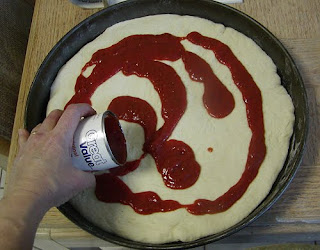 After the dough gets rolled out and put into the pan, I add the sauce. Spread it out over the dough, leaving an edge around the outside that is uncovered. After the sauce is spread on, add about 3/4 of the grated cheese.
After the dough gets rolled out and put into the pan, I add the sauce. Spread it out over the dough, leaving an edge around the outside that is uncovered. After the sauce is spread on, add about 3/4 of the grated cheese.
Be careful not to overload the center of the pizza with cheese and toppings or it will take too long to bake, not getting done before the bottom is too brown. Most of the cheese and toppings go aroung the outside of the center, leaving the outside edge clear, as with the sauce.
 After the cheese, I add the other toppings evenly spread over the pizza, topping it all off with the rest of the grated cheese and a little finely grated parmesan.
After the cheese, I add the other toppings evenly spread over the pizza, topping it all off with the rest of the grated cheese and a little finely grated parmesan.
The pizza needs to be baked at exactly 400 degrees F. Your stove should be calibrated so you can be sure of the temperature. At least put in a stove thermometer and see if it is off. That way you can adjust the setting to get exactly the temperature you need.
Bake the pizza for exactly 20 minutes. One minute longer and the bottom will be a bit too dark. If you don't bake it long enough, the center will not be completely cooked and will be soggy.
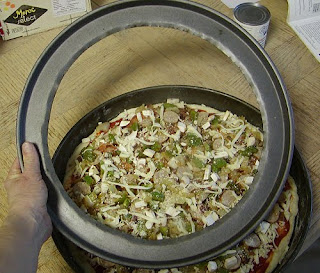 After the pizza has baked for 12 minutes, put a ring around the outside crust area. We use this one that hubby made many years ago from another flat pizza pan. An aluminum foil collar will also work.
After the pizza has baked for 12 minutes, put a ring around the outside crust area. We use this one that hubby made many years ago from another flat pizza pan. An aluminum foil collar will also work.
 Remove pizza from the oven when the 20 minutes is up. If the center is soggy and not well done, you can turn the oven to broil and put the pizza in to broil for another few minutes. Leave the oven door open to prevent further baking of the bottom of the crust while broiling the top.
Remove pizza from the oven when the 20 minutes is up. If the center is soggy and not well done, you can turn the oven to broil and put the pizza in to broil for another few minutes. Leave the oven door open to prevent further baking of the bottom of the crust while broiling the top.
 Remove the ring around the ege and let it cool a bit before you cut and eat it.
Remove the ring around the ege and let it cool a bit before you cut and eat it.
This crust is fabulous, especially made with the beer and not overdone. Watch the time and temp closely. It is easy to overcook the bottom.
I suppose one could freeze the other half of the bottle of beer in another container for use at a later date or make another batch of pizza dough and freeze it (if one doesn't drink beer, that is).
 The first day of December signals a time for us to start decorating for Christmas. Ever year I make an outdoor Christmas wreath from evergreen branches cut in the woods and grapevine. This year I am going to make some indoor grapevine wreaths, as well.
The first day of December signals a time for us to start decorating for Christmas. Ever year I make an outdoor Christmas wreath from evergreen branches cut in the woods and grapevine. This year I am going to make some indoor grapevine wreaths, as well.
 The grapevines themselves were collect two falls ago, stripped of leaves (the chickens like these) and shaped into circles to dry. You can read about that in a previous post
.
The grapevines themselves were collect two falls ago, stripped of leaves (the chickens like these) and shaped into circles to dry. You can read about that in a previous post
.
 These are just loosely tied and left to harden in that shape. They can be tightened and wired into actual wreaths later. I did this two years ago but did not have the time to make any wreaths with them at that time. It has taken me two years to get around to doing anything with these shaped and dried grapevines. This year I am going to use them.
These are just loosely tied and left to harden in that shape. They can be tightened and wired into actual wreaths later. I did this two years ago but did not have the time to make any wreaths with them at that time. It has taken me two years to get around to doing anything with these shaped and dried grapevines. This year I am going to use them.
I am going to make indoor wreaths first. I will make the outdoor wreaths later this month.
 The indoor wreaths are decorated with the tiny pinecones and acorns from our property, as well as ribbon and various dried berries, bells, tiny Christmas tree balls and any other tiny things you think will look good on it. I collect all kinds of things throughout the year at rummage sales and so forth, just for this purpose. Any tiny extras will look good on a wreath.
The indoor wreaths are decorated with the tiny pinecones and acorns from our property, as well as ribbon and various dried berries, bells, tiny Christmas tree balls and any other tiny things you think will look good on it. I collect all kinds of things throughout the year at rummage sales and so forth, just for this purpose. Any tiny extras will look good on a wreath.
 I collected acorns last fall and left them on the porch all winter. They made an excellent winter food for a squirrel, so I collected more this year and put them inside to dry. The best way to dry pinecones and acorns is with salt. Sprinkle salt on them and it will keep them from mildewing or rotting and will help them dry and open. I collected tiny pinecones and dried them this past spring so they are ready to use. I collected the acorns just a couple of weeks ago but they are still good to use now.
I collected acorns last fall and left them on the porch all winter. They made an excellent winter food for a squirrel, so I collected more this year and put them inside to dry. The best way to dry pinecones and acorns is with salt. Sprinkle salt on them and it will keep them from mildewing or rotting and will help them dry and open. I collected tiny pinecones and dried them this past spring so they are ready to use. I collected the acorns just a couple of weeks ago but they are still good to use now.
 I looked around the field and found these to put on the indoor wreaths, also. I am not sure what they are but they are a weed and are still full of tiny seeds. I will have to be careful to collect all the seeds from these or they will grow in the flowerbed beside the porch or will scatter all over the floor of the craft room.
I looked around the field and found these to put on the indoor wreaths, also. I am not sure what they are but they are a weed and are still full of tiny seeds. I will have to be careful to collect all the seeds from these or they will grow in the flowerbed beside the porch or will scatter all over the floor of the craft room.
I am making the indoor wreaths, indoors where it is warm and I have a convenient plug for the glue gun. A glue gun is necessary for the little things. I don't use glue for the outdoor wreaths as glue doesn't hold the things on well enough for the blast of weather that it might get. I prefer to wire everything on the outdoor wreaths. They don't have many small items attached to them. A glue gun is a necessity for indoor craft work and you will need one for these indoor wreaths.
 After you have the grapevine shaped and dried it is time to make a tight wreath out of it. I reshape it with my hands and tie it with coated wire. The type or colour of the wire is unimportant, as long as it is dark. We are going to cover it with ribbon. Hold the grapevine with one hand while wrapping the wire tightly around it to hold all the pieces in place. Done this way, you can use small pieces of grapevine, as long as you keep the thickness even around the circle.
After you have the grapevine shaped and dried it is time to make a tight wreath out of it. I reshape it with my hands and tie it with coated wire. The type or colour of the wire is unimportant, as long as it is dark. We are going to cover it with ribbon. Hold the grapevine with one hand while wrapping the wire tightly around it to hold all the pieces in place. Done this way, you can use small pieces of grapevine, as long as you keep the thickness even around the circle.
 After you have the grapevine shaped, wrapped tightly with wire all the way around and tied off, you are ready to move on to the next step - covering the wire with wide ribbon.
After you have the grapevine shaped, wrapped tightly with wire all the way around and tied off, you are ready to move on to the next step - covering the wire with wide ribbon.
Start where the wire starts and wrap the ribbon around the wreath, over the initial wire and glue the end in place.
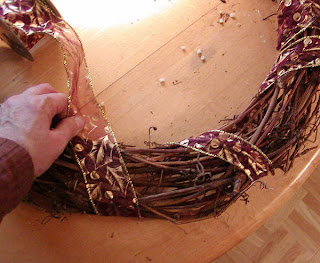

Continue on from there without cutting the ribbon, wrapping it around the wreath over the wire. You should glue it in place over the wire, in several places so it doesn't move off with wear.
 You can use Christmas ribbon, as I have here, or ribbon that matches your livingroom if you want a permanent, non-Christmas, wreath. You can also wrap the wire with paper ribbon or wide raffia. Just be sure to glue the narrower ones in place over the wire.
You can use Christmas ribbon, as I have here, or ribbon that matches your livingroom if you want a permanent, non-Christmas, wreath. You can also wrap the wire with paper ribbon or wide raffia. Just be sure to glue the narrower ones in place over the wire.
When you reach the beginning, cut the ribbon and glue it in place. We are going to cover this beginning spot with a large bow, so glue all the ends of all ribbons and wraps used, in this same location, so that none of the ends will show when the bow is in place. Your next step will be adding the satin ribbon in curls. Glue the end at the "beginning" position where you glued the ends of the other ribbon.
Your next step will be adding the satin ribbon in curls. Glue the end at the "beginning" position where you glued the ends of the other ribbon.
 Roll and curl the ribbon looselly, glueing it at each spot. Don't pull it tight. You will get better curls if you leave it very loose.
Roll and curl the ribbon looselly, glueing it at each spot. Don't pull it tight. You will get better curls if you leave it very loose.
 You may need to move it around a bit to make the best curls and find the best location for glueing. After a bit of practice, this part gets faster and easier. Take the satin ribbon all the way around the front of the wreath, back to the beginning. If you are going around the wreath with it twice, just keep going. If you are changing colours or stopping here, cut it and glue it at the "beginning" place. You can also wrap it around the back of the wreath for a different design.
You may need to move it around a bit to make the best curls and find the best location for glueing. After a bit of practice, this part gets faster and easier. Take the satin ribbon all the way around the front of the wreath, back to the beginning. If you are going around the wreath with it twice, just keep going. If you are changing colours or stopping here, cut it and glue it at the "beginning" place. You can also wrap it around the back of the wreath for a different design.
This "beginning" spot will be where the large bow will be attached. It can be the bottom of the wreath or the top.
 When you decide where the top of the wreath will be, it is a good idea to put on the hanger at the back before glueing a lot of little things onto the front of the wreath. Turn the wreath over on its face and use a bit of wire to make a hanger.
When you decide where the top of the wreath will be, it is a good idea to put on the hanger at the back before glueing a lot of little things onto the front of the wreath. Turn the wreath over on its face and use a bit of wire to make a hanger.
 When you are happy with what has been done so far, it is time to make the bow. You can use the same ribbon you wrapped around the wreath or a different yet coordinating ribbon to make the bow. First cut a piece of wire about 3" long to secure the finished bow. You will not have both hands available to cut the wire after you make the bow, so cut it now and have it ready.
When you are happy with what has been done so far, it is time to make the bow. You can use the same ribbon you wrapped around the wreath or a different yet coordinating ribbon to make the bow. First cut a piece of wire about 3" long to secure the finished bow. You will not have both hands available to cut the wire after you make the bow, so cut it now and have it ready.
 Leaving one long end hanging down, make the first loop. Clench the ribbon in what will be the center of the bow and keep holding it tightly, shaping it with your other hand. This does take a bit of practice but you can take it apart and continue to play with the ribbon until you are happy with it. Twist the ribbon so that the outside is always facing front, holding the twist tightly in the center with your fingers.
Leaving one long end hanging down, make the first loop. Clench the ribbon in what will be the center of the bow and keep holding it tightly, shaping it with your other hand. This does take a bit of practice but you can take it apart and continue to play with the ribbon until you are happy with it. Twist the ribbon so that the outside is always facing front, holding the twist tightly in the center with your fingers.
 Make the loop for the other side, clench it in the center and
Make the loop for the other side, clench it in the center and
let the ribbon hang down for the other end. Cut it off the same length as the first side.
 Keep holding it while you use the previous cut wire to twist around the center and hold the ribbon in place. You can make a bow with two coordinating ribbons, twisting one wire around the center of both.
Keep holding it while you use the previous cut wire to twist around the center and hold the ribbon in place. You can make a bow with two coordinating ribbons, twisting one wire around the center of both.
 Cut a tiny end off the same ribbon or a coordinating colour and make a folded strip to wrap around the center of the bow, over the wire. Glue this in place at the back of the bow. You can make as many loops as you want, for a bigger bow. Just keep making loops with the ribbon, twisting the ribbon so they are all facing outward. When the bow is full enough, leave the end handing as described in the previous paragraph.
Cut a tiny end off the same ribbon or a coordinating colour and make a folded strip to wrap around the center of the bow, over the wire. Glue this in place at the back of the bow. You can make as many loops as you want, for a bigger bow. Just keep making loops with the ribbon, twisting the ribbon so they are all facing outward. When the bow is full enough, leave the end handing as described in the previous paragraph.
 Glue the bow in place on the wreath, covering the "beginning" spot where all the other ribbon ends were glued. If you have been careful to keep these ends glued close together, the large bow should cover them all quite well. If not, you can wrap that spot with wide ribbon until the ends are all well covered, then glue the bow on top of that ribbon.
Glue the bow in place on the wreath, covering the "beginning" spot where all the other ribbon ends were glued. If you have been careful to keep these ends glued close together, the large bow should cover them all quite well. If not, you can wrap that spot with wide ribbon until the ends are all well covered, then glue the bow on top of that ribbon.
 When you are happy with the ribbons and bows, you can start glueing on the natural decorations. I have a lot of small pinecones and acorns and they are free, so I use a lot of them. I like the look of the pinecones sticking out all around the sides and the middle. I put those on first, since I am using so many of them.
When you are happy with the ribbons and bows, you can start glueing on the natural decorations. I have a lot of small pinecones and acorns and they are free, so I use a lot of them. I like the look of the pinecones sticking out all around the sides and the middle. I put those on first, since I am using so many of them.
 Fill in the spots evenly with acorns, keeping the wreath artfully balanced. The seed pods are next.
Fill in the spots evenly with acorns, keeping the wreath artfully balanced. The seed pods are next.
 Some pinecones and small decorations can be placed above and below the bow.
Some pinecones and small decorations can be placed above and below the bow.
 After the natural filler is in place, you can add the colourful decorations. I try to place these where they will cover up any glued ribbon spots that show or any other small problem areas. The larger, brighter and more visible ones come first. These are placed in a fairly balanced pattern around the wreath.
After the natural filler is in place, you can add the colourful decorations. I try to place these where they will cover up any glued ribbon spots that show or any other small problem areas. The larger, brighter and more visible ones come first. These are placed in a fairly balanced pattern around the wreath.
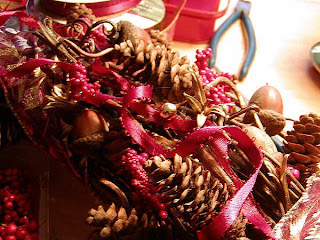 The small decorations are then glued wherever they are needed and are scatted about, still keeping the wreath balanced.
The small decorations are then glued wherever they are needed and are scatted about, still keeping the wreath balanced.

I used small gold beads that I have had for years and not used, some fake red berries cut from another decoration that I bought for this purpose and took apart and some small bits of baby's breath.
Red and Green baby's breath looks good on Christmas wreaths, but I only have white at the moment and I think the white helps to brighten it up, if needed.
 When you are happy with your wreath, hang it in a place of honour on the inside of the front door, on the wall or on the door to another room in your house.
When you are happy with your wreath, hang it in a place of honour on the inside of the front door, on the wall or on the door to another room in your house.

 For this project you are going to need grapevine dried into a circle, covered wire, thin light wire, pinecones and evergreen branches. You can also add any little red berries and bells that you might have and you will need a big bow.
For this project you are going to need grapevine dried into a circle, covered wire, thin light wire, pinecones and evergreen branches. You can also add any little red berries and bells that you might have and you will need a big bow. Start with the same grapevine as in the previous post. The directions are the same as far as making the initial wreath, however, for an outdoor wreath you need to wrap the wire closer. All of the greenery stem will be held in place by the wire, so it needs to be wrapped close for a full wreath.
Start with the same grapevine as in the previous post. The directions are the same as far as making the initial wreath, however, for an outdoor wreath you need to wrap the wire closer. All of the greenery stem will be held in place by the wire, so it needs to be wrapped close for a full wreath. When you have the wreath completely wrapped with wire and the hanger on the back then you prepare the pinecones. Any pinecones will look good. I have both the short, squat, round ones and the long, curved ones. I am going to use the long, curved ones for this wreath. The pinecones are wired to the wreath so they can withstand outdoor winds.
When you have the wreath completely wrapped with wire and the hanger on the back then you prepare the pinecones. Any pinecones will look good. I have both the short, squat, round ones and the long, curved ones. I am going to use the long, curved ones for this wreath. The pinecones are wired to the wreath so they can withstand outdoor winds.


 Cut the greenery into small pieces. I have collected both pine and cedar here. It takes a lot to make a wreath, more than you think. I made one large full wreath from one wheel barrow full of greenery. Any everygreen will make a nice wreath. I have also used spruce which looks very nice. I particularly like the cedar due to the sweet scent, but the spruce has a stong everygreen scent that is nice too.
Cut the greenery into small pieces. I have collected both pine and cedar here. It takes a lot to make a wreath, more than you think. I made one large full wreath from one wheel barrow full of greenery. Any everygreen will make a nice wreath. I have also used spruce which looks very nice. I particularly like the cedar due to the sweet scent, but the spruce has a stong everygreen scent that is nice too.



 Using the clippers, remove any small pieces that cover a pinecone. Make sure you leave enough greenery to cover any wire.
Using the clippers, remove any small pieces that cover a pinecone. Make sure you leave enough greenery to cover any wire.
 Directions for making a bow are on the previous "Indoor Wreath" blog post.
Directions for making a bow are on the previous "Indoor Wreath" blog post. 









































